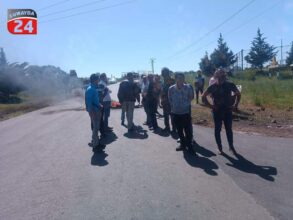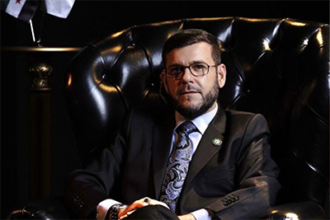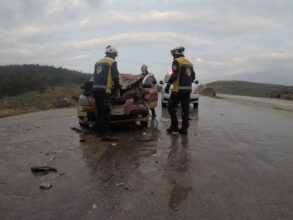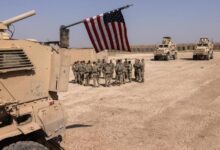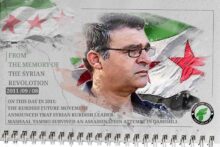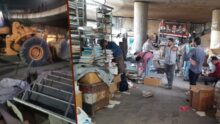Syrian Revolutionary Art: Its Impact and Influence
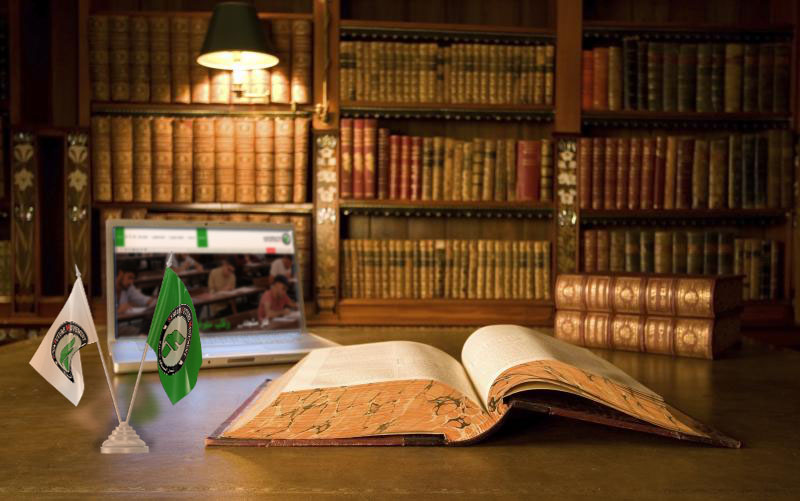
Eli Abdo argues in an article about the impact of art on the Syrian movement that Syrian revolutionary songs cannot be considered committed art. He uses the songs of Marcel Khalife as a model, especially his song “Walking Tall,” believing that “most of what is called committed art, illusions and childish dreams were mixed with metaphors, symbols, and innuendos, which made these songs contribute, unbeknownst to their creators, to generating a false consciousness that deceives those affected by it and ideologically indoctrinates them in a negative way.” In contrast, Syrian revolutionary songs like “Yalla Erhal Ya Bashar” avoid generalities and specify the opponent, considering clarity as one of the main differences between committed art and Syrian revolutionary songs. The author adds, “The steadfastness shown by songs of committed art, resulting from the readiness and finality of the words, is countered by Syrian revolutionary songs with great flexibility.” Therefore, the impact of committed art is limited to mobilization, detached from the context of issues and their hot events, making it non-interactive in the eventfulness of the struggle, and its contexts, while Syrian revolutionary songs seem closer to the masses’ sentiment, where events create the songs, and not the language or its metaphors, making their impact stronger.
In addition to the issue of desacralization in revolutionary songs, which moved away from the ideology that characterized committed art and forcibly brought it into the realm of the sacred. But have revolutionary songs continued with this narrative? The truth is that Syrian revolutionary songs also included a side of commitment, in terms of avoiding specifying the opponent, limiting to mobilization, and lacking daily interaction with the struggle, especially when the Syrian revolution moved to the armed side, like the Free Army’s songs, or general songs like “Jannah Jannah Ya Watana,” and “Izrib,” and later, songs by Islamic groups which mostly carried the Gulf melody theme, such as: “Salil al-Sawarim.”
Overall, according to Sultan Jalabi’s study, “The revolutionary songs that accompanied the civil movement against the authority in Syria were characterized as the most dispersed in the discourse they broadcast, and although in specific aspects of their discourse they were the most cohesive, compared to other musical styles, as is the case with the depiction of the other or opposing side in the conflict, where all the songs referred to the authority embodied in the Assad regime! However, these songs showed greater dispersion in other aspects of their discourse, such as the most repeated words, the calls contained in the songs, as well as in the musical genre and structure.”
In terms of representation: There is a scarcity of plays that spread the grand narrative of the Syrian revolution, despite the existence of individual theatrical movements, works of artist Nawar Bulbul for example, and the works of the “Sabah” cultural team led by Syrian youth inside Syria.
In the cinematic aspect, it appears more in the documentary side, like the film “The Path to Freedom” by director Mahmoud Yekn, and “Return to Homs” by director Abdul Rahman Al Nahas, in addition to short films like “The King Does Not Die” by director Yamen Al Maghribi. However, the film “The Unknown Soldier” by director Abdul Rahman Al Nahas was able to depict the life of the revolutionary Syrian youth in a narrative way. Cinema critic Nadeem Jarjoura elaborates on the brilliance of Syrian revolutionary documentary cinema and its rarity in narrative form.
As for radio work, the series “Yarmouk” broadcast by the British Broadcasting Corporation (BBC) represents one of these few works.
In terms of dramatic work, the close association with the series “Al Wilada Min Al Khasira,” despite the participation of actors loyal to the Syrian regime, is considered the first series to dramatically talk about the Syrian revolution from its beginnings through its militarization, in addition to the series “A Minute of Silence” that approached the intelligence authority’s evil in Syria with grey eyes, as it can be considered the series “Amal” which talks about the torture in Assad’s prisons as a Syrian series talking about the Syrian reality, as well as the series “Smile, General” being one of the most famous series that talked about Bashar Al-Assad’s authority in a dramatic way.
In the visual arts aspect, the “Myths” exhibition in Doha represents one of the manifestations of the revolution’s impact on visual art, in addition to the “Drawing” exhibition, which was held in the Syrian city of A’azaz.
Conclusion:
From the foregoing, it is apparent that art managed at the beginning of the Syrian revolution to be both influenced by and impactful on the Syrian movement. Subsequently, the rest of the artistic output can be considered more as being influenced rather than being influential, especially in its documentary aspect. Therefore, the need today is greater than ever before to support Syrian art as a factor influencing the Syrian reality, not just as being influenced! Hence, we in the Syrian Future Movement (SFM) recommend the following:
- Supporting Syrian art in all its forms, art that aligns with the principles of the Syrian revolution, through the participation of personalities and artistic names that have a history of struggle since the beginning of the Syrian revolution with artists inside Syria. Here, we state that we have begun working at the SFM headquarters in Azaz and Afrin to offer whatever support we can for artistic work and are currently developing plans related to this field. We are open to any proposal or addition that could benefit these plans.
- Shifting Syrian art from the committed side to the interactive side with reality, or uniquely combining both, by presenting theatrical, acting, or cinematic scenarios that speak about the current reality, especially the state of factionalism and the multiplicity of zones of influence, in addition to social topics that concern Syrians inside and those in countries of refuge outside Syria. Working on developing a liberation policy based on a clear vision and strategy that distances itself from political quotas, conflicting agendas, sectarian or denominational propositions, and stays away from populist or extremist rhetoric.
- Collaborating with international institutions to produce artistic works.
- Focusing on visual and theatrical works inside Syria, where we in the SFM offer our support, especially at our headquarters in Azaz and Afrin for these works.
- Rejecting “sectarian, violent, and terrorist” art that has harmed the Syrian revolution, as has the Syrian regime.
- Engaging with experts to create a strong national artistic methodology.
- Concentrating on addressing the Arab and Western public in addition to the Syrian audience to counter the narrative of the Syrian regime or extremist groups, and documenting cooperation with the Arab and Western art sector.
- Encouraging Syrian businessmen to invest in revolutionary art to liberate it financially from those who are not morally and ethically concerned with the Syrian cause, and seeking self-financing, especially for the artistic bearers of the Syrian revolution.
- Training and qualifying for professionalism and the exchange of experiences, encouraging and supporting successful experiments.
- Establishing an art school with all its specializations in Northern Syria, and we recommend that the University of Aleppo in the liberated areas undertake such a pioneering and distinctive project.
Finally, we strongly recommend the following:
- Establishing a Supreme Council for Syrian Revolutionary Art, unifying all artistic efforts through it to organize and support them, and presenting our national message through it to the whole world.
Wahiba Al-Masri
Media Office
Research and Studies Department
Studies
Syrian Future Movement (SFM)
References:
- Songs of Conflict in Syria (1): Jihadists Most Saddened and Angered – Daraj
- ‘Drawing’ Exhibition in Azaz Simulates the Reality of Syrians (rozana.fm)
- A Pictorial Approach to the Syrian Revolution in an Exhibition in Doha | Culture News | Al Jazeera Net (ajnet.me)
- Amal Series – 1: The Syrian Revolution.. Hope and Pain | Amal ᴴᴰ Arabic Television Drama – 1 (youtube.com)
- The Drama of the Syrian Revolution (2).. Birth from the Flank (ultrasawt.com)
- 10 Syrian Films in 10 Years of Revolutions… Image Tests and Language Discoveries – Romman Cultural Magazine (rommanmag.com)
- “Syria: Women in War”.. The Revolution Through the Eyes of Its Heroines | Art | Al Jazeera Net (aljazeera.net)
- The Revolution’s Films: Documenting Syrians’ Memories Beyond Censorship (alaraby.co.uk)
- Ideologization of Singing (Content Analysis of Musical Styles in the Syrian Conflict) – Harmoon Center for Contemporary Studies (harmoon.org)
- The Discursive Structure of Syrian Revolution Media and Representation of Conflict and Values | Al Jazeera Center for Studies (aljazeera.net)

